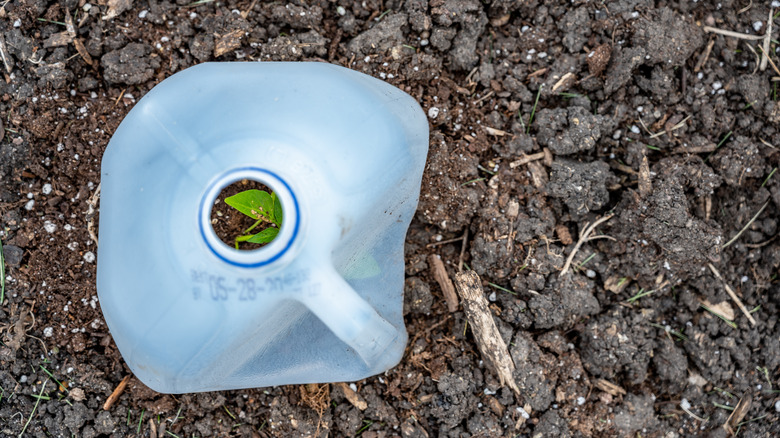The Milk Jug Hack That'll Help With Transplanting Your Garden
When you're getting a veggie garden started, the tender seedlings you're nurturing may need a little extra protection from the elements to get their roots down. Empty plastic milk jugs serve as perfect recyclables when it comes to creating covers that reduce transplant shock. All you need is a sharp utility knife to get started. Turn the jug on its side and cut off 2 or more inches off the bottom of the jug. The top will serve as your plant cover, and you can punch holes in the bottom half to save for a future seedling planter if you like.
Both gallon and half-gallon jugs are suitable for this purpose. Gallon jugs work well with squat plants, while half-gallon jugs are a great fit for taller plants. Keep these on hand any time you expect low temps that might shock your plants or inclement weather like heavy rain or hail. Poking a stick or dowel carefully through the hole into the surrounding soil can help keep the cover in place when it's windy. When it's not so windy, you can screw the cap on the jug for extra short-term for extra protection. Just remember to remove it within a day or two so that your seedlings can get the adequate airflow they need to grow.
How milk jugs protect your plants
Stating the obvious, a hard plastic milk jug cover is going to keep your new seedling from getting flattened by bad weather since it will serve as a protective dome. Small animals like birds and rabbits looking for a tasty snack will also be kept at bay while your covers are in place. Some people even use milk jugs cut in half to start veggie seedlings like broccoli and peas indoors and then transfer the labeled tops outside for shock protection once the transplants are moved to their garden beds.
But how do milk jugs actually keep your plants from succumbing to transplant shock during spring cold snaps or early frosts? Effectively, they serve as mini greenhouses. In the same way that a larger greenhouse allows light to enter the structure, the plants absorb it, and heat is then generated that gets trapped within the jug. When the lid is on, you'll probably even notice some condensation resulting from the greenhouse effect. So yes, you can easily recycle milk jugs to create some individual greenhouses and give your tender little transplants a fighting chance against the elements.
